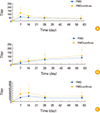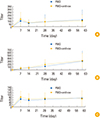1. Republic of Turkey Ministry of Agriculture and Forestry. Turkish national risk based strategy plan for FMD. Ankara: Republic of Turkey Ministry of Agriculture and Forestry;2015.
2. Diaz-San Segundo F, Medina GN, Stenfeldt C, Arzt J, de Los Santos T. Foot-and-mouth disease vaccines. Vet Microbiol. 2017; 206:102–112.

3. Meeusen EN, Walker J, Peters A, Pastoret PP, Jungersen G. Current status of veterinary vaccines. Clin Microbiol Rev. 2007; 20:489–510.

4. European Medicines Agency. Guideline on the requirements for combined vaccines and associations of immunological veterinary medicinal products (IVMPs). London: European Medicines Agency;2013. p. 1–12.
5. Kollaritsch H, Rendi-Wagner P. Immunization. In : Keystone JS, Freedman DO, Kozarsky PE, Connor BA, Nothdurft HD, editors. Travel medicine. 3rd ed. New York: Saunders;2013. p. 67–77.
6. De Clercq K, Koenen F, Strobbe R, Debecq J. Simultaneous vaccination of piglets against foot-and-mouth disease and classical swine fever. Vet Microbiol. 1989; 20:215–221.

7. Hedger RS, Taylor WP, Barnett IT, Riek R, Harpham D. Simultaneous vaccination of cattle against foot-and-mouth disease and rinderpest. Trop Anim Health Prod. 1986; 18:21–25.

8. Drabek J, Flachsel P, Hubik R, Dedek L. Report of the Session of the Research Group of the Standing Technical Committee of the European Commission for the Control of Foot-and-Mouth Disease. Influence of vaccines against swine fever, erysipelas and parvovirosis on the immune response in FMD vaccination of pigs. Prague: Food and Agriculture Organisation (FAO);1988.
9. Joseph PG, Hedger RS. Serological response of cattle to simultaneous vaccinations against foot-and-mouth disease and haemorrhagic septicaemia. Vet Rec. 1984; 114:494–496.

10. Trotta M, Lahore J, Cardoso N, et al. Simultaneous immunization of cattle with foot-and-mouth disease (FMD) and live anthrax vaccines do not interfere with FMD booster responses. Trials Vaccinol. 2015; 4:38–42.

11. Srinivasan VA, Reddy GS, Rao KA, Kihm U. Serological response of bovines to combined vaccine containing foot and mouth disease virus, rabies virus, Pasteurella multocida and Clostridium chauvoei antigens. Vet Arhiv. 2001; 71:37–45.
12. Hanci I, Gurcan IS, Sonmez A. The effect of simultaneous application of Brucella and FMD vaccines on antibody level in cattle and sheep. Etlik Vet Mikrobiyol Derg. 2016; 27:27–37.
13. Castaneda J, Espinoza M, Bernal C, Jimenez J, Aguirre L. Simultaneous vaccination of cattle with foot-and-mouth disease and vesicular stomatitis live virus vaccines. Dev Biol Stand. 1976; 35:429–436.
14. Dagan R, Eskola J, Leclerc C, Leroy O. Reduced response to multiple vaccines sharing common protein epitopes that are administered simultaneously to infants. Infect Immun. 1998; 66:2093–2098.

15. Ozkurt Z, Parlak M, Tastan R, Dinler U, Saglam YS, Ozyurek SF. Anthrax in eastern Turkey, 1992–2004. Emerg Infect Dis. 2005; 11:1939–1941.

16. Noseda RP. Situacion del Carbunclo rural en la Argentina 2012. Rev Electron Vet. 2013; 14:1–9.
17. Braun RO, Brunner L, Wyler K, et al. System immunology-based identification of blood transcriptional modules correlating to antibody responses in sheep. NPJ Vaccines. 2018; 3:41.

18. Darie PC, Ionita P, Petrosanu O, Eustafievici MD, Simon E, Mircescu G. Simultaneous vaccination of intensively reared lambs against anaerobes, anthrax and foot and mouth disease. Lucr Inst Cercet Vet Bioprep. 1979; 15:75–78.
20. Hamblin C, Barnett IT, Hedger RS. A new enzyme-linked immunosorbent assay (ELISA) for the detection of antibodies against foot-and-mouth disease virus. I. Development and method of ELISA. J Immunol Methods. 1986; 3:115–121.

21. Lyons NA, Lyoo YS, King DP, Paton DJ. Challenges of generating and maintaining protective vaccine-induced immune responses for foot-and-mouth disease virus in pigs. Front Vet Sci. 2016; 3:102.

22. Phaswana PH, Ndumnego OC, Koehler SM, Beyer W, Crafford JE, van Heerden H. Use of the mice passive protection test to evaluate the humoral response in goats vaccinated with Sterne 34F2 live spore vaccine. Vet Res. 2017; 48:46.

23. Ascough S, Ingram RJ, Altmann DM. Anthrax lethal toxin and the induction of CD4 T cell immunity. Toxins (Basel). 2012; 4:878–899.

24. Brown RD, Taylor WP. Simultaneous vaccination of cattle against rinderpest and contagious bovine pleuropneumonia. Bull Epizoot Dis Afr. 1966; 14:141–146.
25. Aly AA, Kamal NA, El-Sehemi MM, Osman RM, Daoud AM. Synchronous vaccination of sheep with both attenuated Pest Des Petits Ruminants (PPR) and polyvalent clostridial vaccines. In : The 3rd International Scientific Conference; 2003 Apr 29–30; Mansoura, Egypt. p. 1–10.
26. Mehanna AM, Hanan AR, Daoud AM. The performance of both Pest Des Petits Ruminants (PPR) and Brucella melitensis Rev-1 vaccines concurrently administered to sheep. Mansoura Vet Med. 2004; 6:131–142.
27. Elbayoumy MK, Ghattas WM, Allam AM, Mahmoud AF. Immunological studies for using of combined inactivated respiratory virus vaccine (Pneumo-3) and sheep pox vaccine in goats. Acad J Anim Dis. 2013; 2:1–6.
28. Kasem S, Fatah SA, Khodier M, Desouky A. Evaluation of the efficacy of simultaneous vaccination of cattle against rabies and foot and mouth disease viruses. Glob Vet. 2017; 18:226–233.
29. El-Bagoury GF, El-Habbaa AS, Gamil MA, Fawzy HG. Evaluation of an inactivated combined oil vaccine prepared for foot and mouth disease virus and bovine ephemeral fever viruses. Benha Vet Med J. 2014; 27:221–231.
30. Gamal WM, Soliman EM, El-Manzalawy MA. Tracing the antibody mediated acquired immunity by foot and mouth disease and rift valley fever combined vaccine in pregnant ewes and their lambs. Vet World. 2014; 7:922–928.

31. Chhabra R, Sharma R, Kakker NK. Comparative immunogenecity of foot and mouth disease virus antigens in FMD-haemorrhagic septicaemia combined vaccine and FMD vaccine alone in buffalo calves. Indian J Exp Biol. 2004; 42:259–264.
32. Lauer KB, Borrow R, Blanchard TJ. Multivalent and multipathogen viral vector vaccines. Clin Vaccine Immunol. 2017; 24:e00298–e00216.

33. Elham AY, Abeer EM. Simultaneous vaccination of cattle with polyvalent pneumonic pasteurollosis vaccine and bivalent fmd vaccine (O & A). SCVMJ. 2008; 13:543–553.






 PDF
PDF ePub
ePub Citation
Citation Print
Print




 XML Download
XML Download